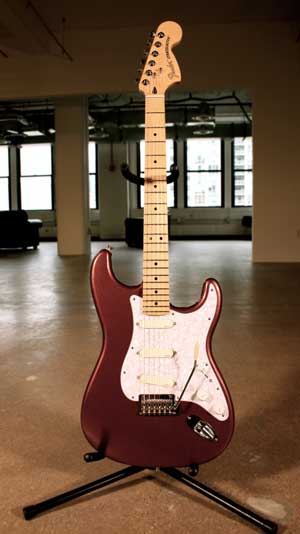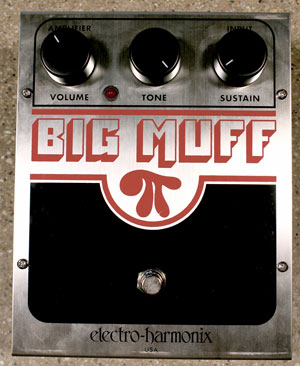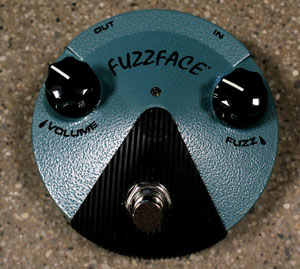David Gilmour, the legendary guitarist of Pink Floyd, successful solo artist in his own right, and 20-year veteran of the US Rock and Roll Hall of Fame, has been wowing fans for decades with his tasteful brand of guitar playing. Gilmour’s hallmarks are smart chord progressions, great phrasing, and tone to kill for. He was a natural choice for our Legends of Tone video series, and I was completely prepared for the task of bringing him to life for the first installment of this series. After all, David Gilmour is easily in my Top 5 list of rock guitar players even today…what a cliché, huh?
For starters, I’ll bring up some of the gear he’s most famously associated with, and how we attempted to replicate his tone, specifically from 1973-1979, with a few old and new favorites for our video. I’ll end this rundown with a few technique tips for anyone trying to add a little Gilmour to their repertoire.
Learn more about David Gilmour’s Gear on zZounds
The Legendary Gear

Fender Custom Shop David Gilmour Black Strat NOS
Historically, Gilmour was most often associated with his Fender Stratocaster dubbed “The Black Strat,” a late ’60s model he bought in 1970 after his rig was stolen on tour in North America. Throughout the years, he was no stranger to other guitars like Gibson Les Paul Gold Tops, as well as Telecasters, and several other Strats, including his mid-60’s white Strat, and his 1983 red Strat. Another key component of his tone is his usage of Hiwatt amps like the DR103 unit powering WEM Super Starfinder 200 4×12 cabinets. With a few exceptions, Gilmour generally would run two Hiwatt heads (and one spare) powering four 4×12 Starfinder cabinets. That’s a lot of amp! It got up to a shocking SIX Hiwatt heads for Pink Floyd’s 1994 Division Bell Tour.
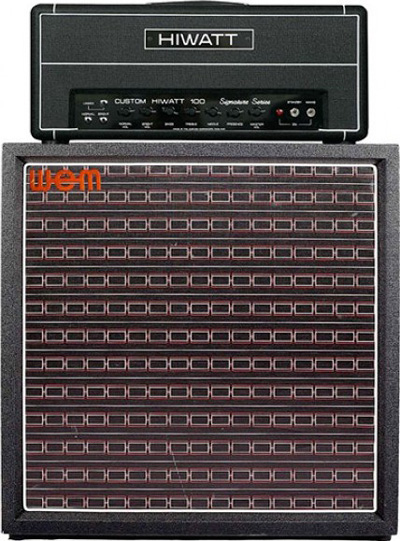
A Hiwatt DR-103 atop a WEM Super Starfinder cabinet
Besides this, Gilmour used Big Muff pedals, Fuzz Faces, MXR Phase 90s, Binson Echorecs, Vox Wahs, DeArmond volume pedals, Colorsound Power Boosts, UniVox Uni-Vibes, Leslie 147 rotating speaker cabinets, and a ton of other effects and toys. The list goes on and on, so we tried to choose a few fan-favorite sounds for our video to demonstrate just a few of the classics. Faced with this task, we felt pretty confident the gear of today would be able to pull it off.
One Key Piece of Gear
If you want David Gilmour’s tone but aren’t sure where to start, get a Fender Stratocaster. It’s kind of like the Swiss Army knife of the guitar world. A Strat really is a necessary component here because of the way in which it responds to a wide variety of gear. And as we’ve discussed, Gilmour was no stranger to trying out new additions to his rig. Take for instance, the opening of our video: a nod to “Shine On You Crazy Diamond.”
In the original song, the simple 4-note motif sounds inquisitive, yet haunting, and it’s all tied together with the clarity of sound that Gilmour’s Strat provides. The wide selection of pickup combinations allows that line, which seems to be done with the neck or neck/middle pickup combination, to sound unique. It’s a sound that sticks with you once you hear it and is nearly impossible to forget, as any Pink Floyd fan surely knows.
Stratocasters also work great for funky rhythms, as heard in the second section of our video, an homage to “Another Brick in the Wall, Pt. 2”, as well as with a ton of drive for solos. It’s really no surprise David still reaches for one even today to achieve his wide variety of sounds.
The Gear We Used
For our video, we opted to use a Fender Deluxe Roadhouse Stratocaster and then swapped out the pickups for an EMG DG20 David Gilmour custom loaded pickguard. This allowed us to tap into Gilmour’s ’80s/’90s tone: really clear definition to our cleans, and superb handling of overdrives. The EMG pickups offered a nice boost in output that we utilized as well. The installation was simple: the pickguard comes with solderless connectors so no guitar repair skills were necessary. Just remove your old pickguard and pop this one in. Our process was made a bit easier because the Deluxe Roadhouse Strat comes stock with a battery compartment cavity for its on-board V-6 switch. If you are installing the DG20 on a guitar with passive electronics, you can still mount the 9V battery underneath your Strat’s rear tone control pot.
A cool feature found on the DG20 pickguard is the EXG Guitar Expander (controlled by the front Tone knob), and the SPC Presence Control (controlled by the rear Tone knob). Respectively, the EXG boosts the low and high frequencies and cuts the middle frequencies to help fill out your tone, while the SPC Presence Control is a midrange boost with a slight high-end rolloff that simulates the tone of a humbucking pickup. Because the EQ effects are bypassed when rolled to zero, EMG recommends starting there and slowly rolling in the knobs to your desired settings.
Installing the David Gilmour pickguard onto the Deluxe Roadhouse Stratocaster.
A couple of other pieces of gear that made appearances were the MXR Phase 90 (not much different than when Gilmour was using it back then), and the MXR Studio Compressor. The classic Phase 90 is a downright gem that we all know and love, and is still stupid simple to operate with only a single knob.
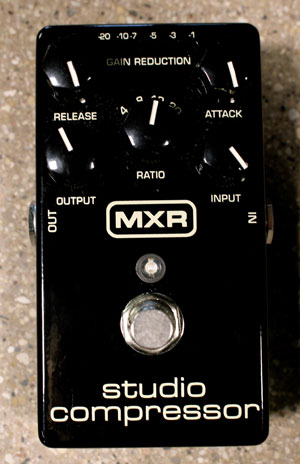
We used an MXR Studio Compressor to achieve Gilmour’s solo tone from “Another Brick in the Wall, Pt. 2.”
Another pedal, the MXR Studio Compressor, was really awesome for helping us achieve Gilmour sounds that were heavily compressed. For the studio solo on The Wall’s “Another Brick in the Wall Pt. 2,” the engineer James Guthrie took a clean signal that was compressed and fed it into the mixing console, sent it out to a Mesa/Boogie amp, and sent it back into the console again to get the famed tone. Needless to say, we couldn’t do all that very easily, so we reached for the MXR Studio Compressor to dial in the sound. To top it all off, we added an Electro-Harmonix Big Muff, and a 2017 Gibson HP Les Paul Standard. (Fun Fact: Gilmour actually did use a 1955 Goldtop Les Paul Standard with P-90 pickups for the famous solo on that song, debunking any claims that he got a Strat to sound like that). The result was a really great and super spanky clean tone that we blended with the grit from the Big Muff. We felt it was a pretty good approximation of that solo’s tone, considering it is literally impossible to replicate the response of Guthrie’s specific mixing console! Lastly, lending support behind the guitar solo was a great sounding B3 organ patch from the Arturia V collection that we had a little fun experimenting with too.
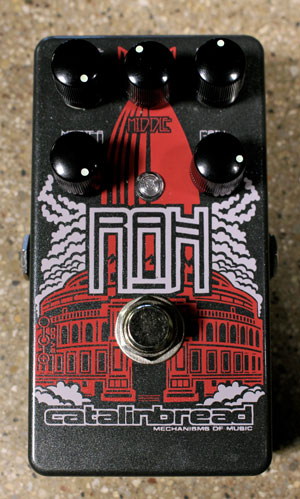
We used the Catalinbread RAH to emulate the tone of a Hiwatt amp on “Shine on You Crazy Diamond.”
For the lead tone on “Shine On You Crazy Diamond,” we went for a Strat through that same MXR Studio Compressor, and then through a Catalinbread RAH overdrive pedal. The choice of the RAH pedal was strategic: we didn’t have a Hiwatt amplifier around to use, but the pedal’s function is a Hiwatt-style amp clone. Specifically, the Hiwatt tone Jimmy Page got during the classic 1970 Royal Albert Hall Led Zeppelin performance (hence R-A-H). Naturally it seemed like a no-brainer to use it, but because we were getting even more adventurous with our tonal options, we opted to blend that signal in with a Hiwatt amp sim plugin from Universal Audio as well. We liked that so much we kept it in.
Finally, we ended our demo with a version of Dark Side of the Moon’s classic tune “Time.” While the song itself is beautiful for many reasons, the real star is the wonderful guitar solo. It’s got to be one of the most famous solos of Gilmour’s entire catalogue, and yet after all of these years of listening to it, I still struggle to explain exactly why I love it so much. It’s sorrowful, emotionally charged, and full of blues attitude, yet somehow retains this sense of optimism and fearlessness. All that being said, it only takes a few things to replicate the tone: a Fuzz Face pedal, and an Echorec unit.
Dialing it in
Gilmour used an old ’60s Binson Echorec delay unit to achieve those super swampy delay tones he was known for. The Echorec was a large, Italian-made unit run with 6 12AX7 tubes and an AC motor that ran a specially designed rotating steel drum with play heads positioned around it. Because the drums could be independently operated, you could create an echo sound that had specific rhythms and patterns generated by those combinations. Gilmour used a Binson Echorec from 1968 when he first joined Pink Floyd, all the way up to the 1977 tour of their album Animals. Check out Floyd’s 1972 concert Live at Pompeii to see David dial in his famous “violin” tones with a slide and you’ll see the Binson unit in action. Pretty sweet. Again, we surely were not going to be able to track one down, let alone a working unit, so we poked around for something to use as an alternative.
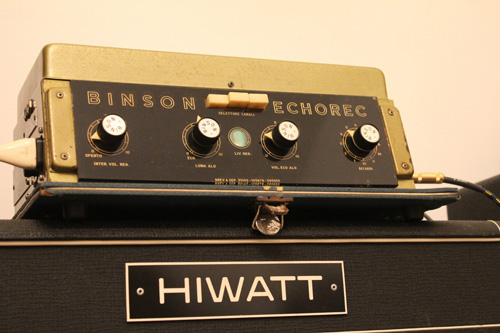
An original Binson Echorec perched appropriately on a Hiwatt amp
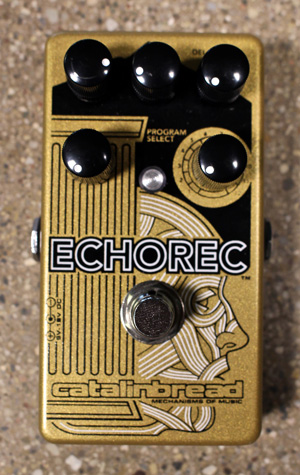
Catalinbread’s Echorec delay pedal
In came Catalinbread once again with a great pedal called….wait for it….the Echorec! This is probably one of the very best modern pedals simulating the effect of the Binson unit that you can find. We used the Swell mode, which adjusts the amount of repeats, turned up decently high (6-7), and did the same with the Mix control to get the reverb-esque delay tone heard on the “Time” solo. But before our signal reached the Echorec, we used a Dunlop FFM3 Jimi Hendrix Fuzz Face Mini pedal for our drive tone. Fuzz Faces have great sensitivity — run your guitar’s volume knob up high to get full gain and some snarl, or lower it to make the tone smoother and subtle. Gilmour would regularly roll his volume knob down to clean up his tone for his rhythm parts. However, we operated it the way David did on the album, which was diming the Fuzz and Volume controls and keeping the guitar’s volume up high for his solo. When we finally ran the Fuzz Face through the Echorec pedal, we got a great modern version of the famed solo tone with minimal effort.
The Technique
Getting Gilmour’s tone is one thing, but now you have to know what to do with it! It would be an understatement to say that Gilmour is careful about his note choices — he’s really careful. He never was much of a flashy player and instead chose to make sure that each note he played served the song appropriately. Because of this simple fact, he’s a guitarist whose secret is hard to describe. I always thought it was Gilmour’s insanely tasteful and vocal bends that made him sound so unique, so working on your bends is a great start. Make sure to retain good intonation and execute them cleanly for full effect – it can be detrimental to your solo if your bends aren’t sounding in tune. After you feel comfy with your bends, try them with bend releases and pull-offs. Take it a step further and combine even more techniques like slides with them too. The possibilities can keep you busy for a lifetime.
A prime example of David Gilmour’s technique: “Young Lust” performed live during The Wall Tour in 1980.
The next step is getting your smart blues licks ready to go. Gilmour idolized players like Jeff Beck, who also utilized pentatonic scale licks in really refined ways. Fight the urge to simply shred down your cliché rock pentatonic licks and instead find ways of creating plenty of space with them in your solo. Trust me, it always makes you sound more pro when you make this your aim. Gilmour never underestimates the impact of good phrasing and it clearly shows in each of his solos. Don’t be afraid to throw in a few double stops and plenty of grace notes and slides in between your deliberate phrasings, and you are a good bit of the way there to his sound. I can write nearly forever on the subtleties of Gilmour’s playing, but instead I’d suggest picking out a personal favorite solo and focusing on learning it all the way through. You’ll learn more from just one solo than I could ever tell you here via text.
All in all, David Gilmour is a guitar behemoth that is still highly revered and is currently playing out regularly. Hopefully this brief run-down of a few of his classic gear setups and an even more brief explanation of his playing style helped shed some light on this truly gifted player. He definitely isn’t leaving my Top 5 list anytime soon…
Check out our video that’s linked at the top of this post to hear our homage to the famous tones of the 1970s era (1973-1979) David Gilmour.
PS…while you’re at it – check out the incredible gilmourish.com for everything David Gilmour. The site helped immensely in researching David Gilmour and his gear for this post. You can find information on the rigs he used while on tour, the gear/settings used on specific recordings, and countless other pieces of invaluable information.

